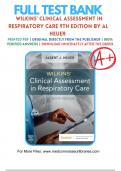Exam (elaborations)
Test Bank for Wilkins' Clinical Assessment in Respiratory Care 9th Edition by Albert J. Heuer
- Course
- Institution
- Book
Test Bank for Wilkins' Clinical Assessment in Respiratory Care 9th Edition by Albert J. Heuer ISBN 9780323696999 Chapter 1-21 | Complete Guide A+. Contents: 1. Preparing for the Patient Encounter 2. The Medical History and the Interview 3. Cardiopulmonary Symptoms 4. Vital Signs 5. Fundamentals of ...
[Show more]



